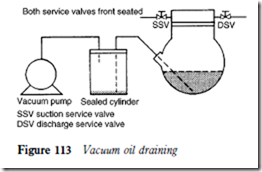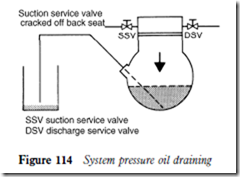Draining compressor oil
This may be necessary when too much oil has been added, when maintenance contracts stipulate a periodic oil change, or when a system has been contaminated.
Assuming that the compressor does not have an oil drain facility and the removal of the base plate or sump plate is impractical or uneconomical, two simple methods may be adopted.
Vacuum method
This requires an air tight container or preferably a graduated cylinder so that the amount of oil removed can be measured and the precise amount replaced.
By pulling a vacuum on the container or cylinder, the oil will be drawn out of the compressor into the cylinder (Figure 113). During this process the compressor must be isolated from the system by front seating the service valves.
System pressure method
With a length of tubing and an adaptor fitted to the filler hole after pressure in the crankcase has been reduced and both service valves front seated, create a positive pressure in the crankcase by cracking off the suction service valve from the front seat position (Figure 114). Provided the tubing reaches to the bottom of the crankcase or sump, the oil will be forced out of the compressor and into the container.
Correcting the oil level
The pressure method above can be used to reduce the level of oil in the crankcase in the event of an overcharge. By fitting an adaptor tube which terminates at the correct level below the crankshaft, oil will be forced out of
the compressor when the crankcase is pressurized, but only until the oil level reaches the end of the tube.

